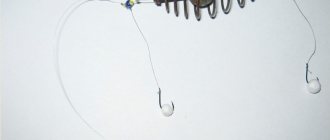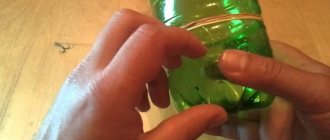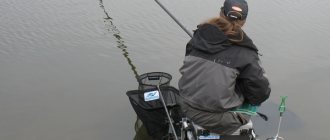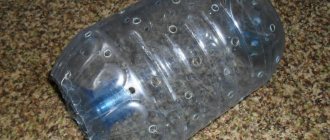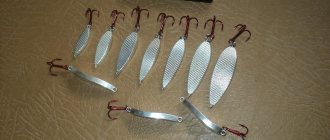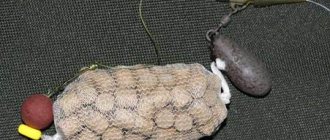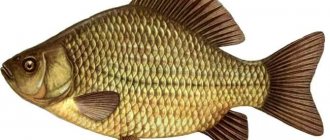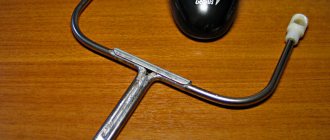Purpose and principle of operation of the feeder
The use of a feeder for fishing has been used for a long time; this fishing item has hardly changed its appearance over the entire period of its existence. Some improvements have been made, the principle of operation remains the same. A feeder for a spinning rod with bait must be selected according to certain parameters; its main task is to deliver the feed to a certain place in the reservoir. After all, good places for catching trophies are not always located near the shore.
Forming the gear involves attaching leashes with hooks on which the catch will be caught. The operating principle of the feeders is simple:
- the product is qualitatively attached to the main fishing line;
- stuffed with enough porridge;
- after entering the water, the contents of the feeder at the bottom will gradually be washed out, attracting the inhabitants of the reservoir with the smell and taste;
- the fish begins to feed, swallows the baited hooks and hooks occur.
All that remains is to bring out the catch and remove it from the hook.
There are different feeders used for catching bream; the choice is influenced by many factors and the personal preferences of the fisherman. An experienced friend will help you understand the wide variety, and it’s worth asking a beginner for advice.
How to choose bait for bream
Spring bait
To fish in reservoirs with a current, it is necessary to add viscosity ; for this, clay from the reservoir and pea flour are used. Fraction : small, but always with the addition of large pieces of live maggots and food bloodworms. Color : light Smell : coriander is the best option Additives to attract large fish: instant corn, crushed peas, scalded maggot
Summer baits
In the summer heat, many complain about a complete lack of bite , but this is not always true. Properly selected bait can attract the attention of bream even in the heat. June: worm, maggot, corn, peas, pasta. July: steamed barley, maggot worms in the form of sandwiches. August: bread, pasta, corn, maggot worm. Temporary decreases in temperature indicators will entail a return of bream to animal types of bait ; vegetable bait should be offered in hot weather.
Autumn lures
In the autumn, bream continue to be actively caught on the feeder; groundbait and bait, as before, should work in tandem in such gear. As the temperature drops, bream will again want “meat” baits. September: earthworm and dung worm, maggot, hominy, bread, steamed cereals. October: bloodworms, worms, less often maggots. November: maggots and bloodworms, plant-based baits will not work. It is important to understand that the bait used in crushed form must be added to the bait.
Winter lures
In winter, bait for bream is very important; it is more difficult for passive fish to attract attention . Therefore, the selection of bait should be approached very carefully. December: sandwiches made from pieces of worms, bloodworms and maggots, less often boiled peas are used. January: bloodworm, worm. February: worm, bloodworm, semolina, peas. You can experiment and try using the dough as bait; at the end of February, bream can respond well to this species.
Hooks, leashes
Bream does not react too strongly to thick fishing line, so you shouldn’t go too thin with the thickness of the leader. For them, monofilament fishing line with a thickness of 0.15 mm is used. A good fishing line of this thickness allows you to pull out solid specimens of this fish, as well as pull the hook out of the hook on the coastal grass and horsetails. The length of the leash must be at least 50 cm. This length can be taken less if a “Gardner loop” type installation is used, subtracting from it the length of the fishing line section from the feeder loop. The fact is that bream is a fairly large fish in length, although not too dense. He adapted to take the bait from the bottom, standing vertically in the water column. At the same time, straightening up, he usually drags her a little to the side.
If the leash is short, he will already feel the feeder on the fishing line at the bite stage and may spit out the bait. A leash for it is set at 70 cm, and a meter, and even one and a half meters, if the fish bites very carefully. In this case, the bite will be noticeable later, and when catching small voracious fish, this would lead to hooks swallowed up to the belly and surgical operations to remove them.
But the bream does not immediately swallow the bait; it drags it to the side, giving a signal of a bite. This allows you to get it out even with such leashes caught on the lips and then carefully remove it and release it into the water if desired. In summer, fish usually bite more boldly, and the leashes for them can be shorter.
Hooks for catching bream are used in accordance with the size of the nozzle. It is also worth considering the size of the fish. Since large baits are used for catching bream, which allow you to cut off bites of small things that come up on the bait table, it is worth using hooks of a decent size. The bream extends its lips and “vacuums” the bottom, collecting food from it, so it will “suck” both the bait and the hook into itself, giving the angler the opportunity to catch it. Too large ones, however, should not be used, as they reduce the intensity of the bite and create the possibility that the fish will feel the metal in its mouth and spit out the bait, especially if it was not installed correctly. If you use small baits, such as bloodworms or maggots, you should use fairly thin hooks. They allow you to plant a bunch of bloodworms without damage.
Share with your friends!
Groundbait for feeders
An important component of fishing with a feeder from a boat or from the shore is bait; without it there is no point in building such gear. Porridge for bream in a feeder can be different, there are the following varieties:
- purchased mixtures with dry or moistened form;
- self-prepared kind.
If the fishing turned out to be spontaneous, it’s easier to go to the store and buy a prepackaged type of food. Experienced fishermen recommend doing it yourself. Bait for bream at home does not take long to cook, but in terms of efficiency it will be much better than store-bought bait.
Requirements for bait
Feeding on a ring for bream fishing is no different in its performance from porridges for other types of feeders. The main requirements for bait are:
- when finished, the color of the complementary food should not contrast with the soil at the bottom of the reservoir;
- the feeding porridge is more crumbly, this will help it fall out of the feeder faster;
- the bait in the fishing trough is more viscous;
- The food must contain bait ingredients;
- the food must have a smell.
Ingredients and flavors may vary depending on time of year and weather conditions.
In cold water in early spring and with the onset of autumn cold, bait for bream at home is made with the addition of animal particles. The summer heat will change the preferences of the fish; at this time of year, vegetable baits will work better.
Groundbait recipes
Most baits are universal; they are used not only for ringing bream. Carp and crucian carp will also appreciate such homemade options.
To catch bream with a ring, everyone has their own complementary feeding recipe; you can change some ingredients, replace some components. Do-it-yourself bream porridge cannot be prepared quickly, but there are options that do not require much time:
- A kilo of cookies is turned into fine crumbs, 100 g of breadcrumbs, twice as much sunflower seed cake, and 100 g of rolled oats flour are added. Everything mixes well, you can add anise oil if desired.
- A feeder for catching peaceful fish on a river or lake is filled with the following composition: a kilo of cooked millet porridge is mixed with a large can of canned corn. In cold weather, chopped maggots, worms, and bloodworms are added to the mixture.
- A simple recipe for ringing would be a mixture of equal amounts of crushed cookies and sunflower cake. For the bunch, add a glass of semolina. Half a kilo of mixed feed or any boiled porridge will be an excellent base for kneading.
The well-known Salapin porridge will be an excellent option for bream fishing in the current. Every self-respecting fisherman knows her recipe.
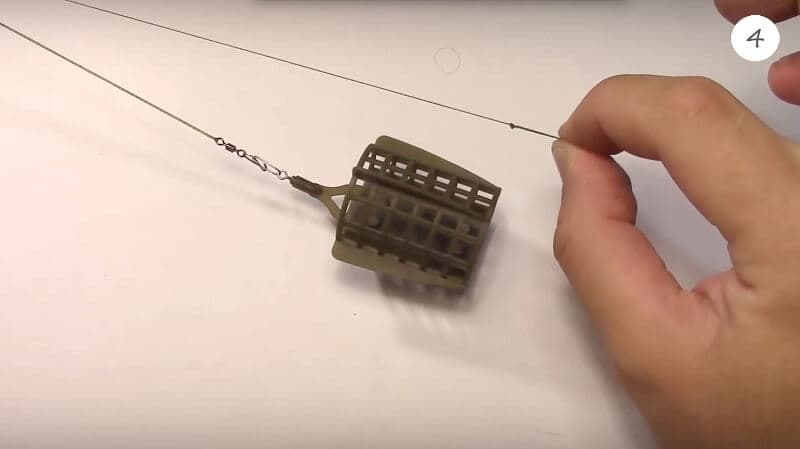
Load of soft feeder for bream in the current
Before filling the net with bait, we estimate the strength of the river current in the place where bream or other “white” fish are caught.
Based on the intensity of the current, we select the weight of weight 1 (see picture below), which we place on the bottom of the soft feeder in such a way that the net with bait is not pulled by the current under the working hole, from which the tackle with the jig is lowered on the fishing line.
If you have too light a load for winter fishing, then the hole for lowering the feeder should be drilled away from the working one, but then it will be more difficult to combine the bait washed out of the feeder with the location of the jig lowered to the bottom for catching bream.
In addition, if the distance between a soft feeder with bait eroded by the current and a jig is too large, then a feeding school of bream or other fish may end up between the feeder and the jig lowered on a line from a winter fishing rod.
And, given that the feeding fish always faces the incoming current, the jig may generally fall out of sight of the bream.
As a load for soft winter feeders, I use a package of several steel washers with a diameter of 80-85 mm, weighing 80-100 grams each. You can use a lead casting as a weight or cut out a piece of lead.
Features of installation of feeders
Tackle for bream using a feeder can be different, the conditions for fishing and the methods used are important.
Feeder tackle
Equipment for catching bream on a feeder will always be catchy if assembled correctly. As a rule, such installation is usually blind; it can be done using different methods. Most often, a bream feeder is assembled using the following methods:
- helicopter and two knots;
- symmetrical loop;
- asymmetrical loop;
- paternoster.
It is advisable to look at each type yourself in order to understand all the intricacies of the procedure.
Which leash is better to use when collecting gear? The main indicator will be the main line; the leader line is chosen to be an order of magnitude thinner. This will help when the tackle gets caught, only the hook will be lost, the rest of the installation can be saved.
Bottom tackle
Not everyone knows how to make a donk with a feeder. Before assembling the tackle correctly, you need to decide where the fishing will be done from. Tackle from a boat is collected in almost the same way as for fishing from the shore, only the rod used will differ.
Bream is often caught using a ring from a watercraft; the gear assembled with your own hands will be more reliable than a purchased analogue. From the shoreline, sliding rigs are often used, so it will be easier to spot wary bream.
Preparing equipment for ring fishing
The design of the gear consists of a ring and a feeder. You can make Florentine with your own hands.
We also recommend reading:
Model range of Salmo wobblers and Salmo Hornet catalog Bait for crucian carp - recipes for super bait with your own hands Spinner for pike - 10 best and how to make it yourself? Tackle and bait for fishing for carp - selection and production
Ring with a secret
Catching tackle can be fixed or removable:
- The permanent Florentine should be 3–5 mm thick and 55 to 65 cm in diameter. A cut is made in its middle with a cross-section of 15 to 20 mm. Thanks to this hole, the ring moves freely along the cord. To prevent the hook from catching on the feeder, a hole with a diameter of up to 7 mm is drilled from the edge of the tackle. It should be at an angle of 30–45 degrees relative to the ring. This hole is used for attaching fishing line and leashes to the ring. If the diameter is smaller, then the main line along with the leads is passed through the hole. A swivel is fixed on the leash side, which will stop the passage through the wiring hole.
- The ring can be made removable if you cut another hole on the side opposite the fishing line, through which the ring will come off the cord during hooking. The hole is sawed at an angle. If the cut is straight, then it is blocked from the self-propelled gun by a door on a spring or crossed antennae made of elastic wire. This Florentine is more reliable because it does not allow the fishing line to get tangled around the feeder.
Fishing technique with a feeder
When fishing with a ring or with another type of feeder, it is important to follow the fishing technique. The main points are:
- complementary foods are thrown into one place;
- When casting, the rod must be vertical relative to the reservoir;
- As soon as the feeder goes into the water, the form is placed on the stand, not forgetting to loosen the clutch.
Having done everything, all that remains is to wait for the bite, for this they use bells, a float for sagging, and in the dark the whip is equipped with a firefly.
Fishing differs slightly in where the water area is fished from.
From the shore
To catch bream from the coastline, feeder rods, pickers are used, even a float rod with a feeder is suitable. All steps are carried out exactly as described above, only the tension of the fishing line is adjusted so that at the slightest movement of the feeder you can see a bite.
On the current
The feeder for fishing in the current is taken heavier, at least 80-100 g, casting occurs in the same way, only the bite is observed by the float for sagging or directly along the tip. Casting is carried out identically, but the washout of food should be checked more often.
From the boat
It is better to offer food to bream from a watercraft using the fishing ring method; it will be much easier to catch bream this way. To do this, they make their own tackle, which they carefully lower next to the boat and wait for bites.
A do-it-yourself feeder will help when catching bream in closed reservoirs; on the river, more purchased options are used, but some craftsmen manage to produce such an element of equipment at home.
You can ask your question to our author:
Stages of catching bream
How to catch bream? Fishing takes place in several stages: feeding fish, attracting bream, catching bream. Before fishing, feeding the bream is done according to the following principle:
- For dense feeding, large feeders are installed.
- Complementary feeding is made from large particles and soil. Their ratio is 3:1.
- The feed should be compacted easily. This is necessary to create a cloud of complementary food in the water area, which helps attract fish.
- It is best if the feeder is emptied on the surface of the reservoir. Feed particles will sink from the surface to the bottom. This will result in feeding a larger area. This method will allow the fisherman to keep the prey in the feeding area for a long time.
- At this time, you can feed and catch bream at the same time. To do this, you need to equip the spinning rod with a long leash from half a meter to one meter.
- In the process of catching bream for an hour, you need to make casts every three minutes.
The first stage of catching bream is to feed it. It is important to create a feeding cloud on the surface of the reservoir. During the feeding process, you can begin to fish for fish.
